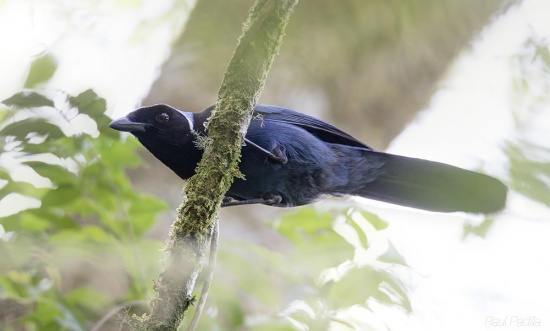
Photo by Padilla Raul Padilla
Tlanchinol, Hidalgo, Mexico, May 2017
Alternative name: Hooded Jay
- Cyanolyca cucullata
Identification
26 - 31cm (10¼-12¼ in).
- Dark cyan-blue plumage
- Black forehead and sides of head, black throat, more extensive in some subspecies
- Pale blue crown, bordered narrow white in mitrata, more extensive in hondurensis
- Dark red eyes
- Black bill and legs
Sexes similar. Juveniles are duller than adults and have light sepia underparts.
Distribution
Central America: found in the highlands from central Mexico south to Guatemala and Honduras with an isolated population (subspecies cucullata) in Costa Rica and Panama.
Taxonomy
Evidence suggests that this taxon is the result of a back colonisation of Central America from South America [8]. Northern populations have diverged from the nominate subspecies such that they may best be treated as a different species, a result supported by vocal evidence as well (see also [7]). The first branching event occurred some 2.8 million years BP. Reference [8] proposes elevating susubspecies mitrata, guatemalae, hondurensis as C. mitrata leaving cucullata in a refined C. cucullata. The main differences are that Northern populations are larger, vocally different and exhibit a more or less white edge to the pale blue crown.
Subspecies
There are 4 subspecies [1]:
- C. c. mitrata: Eastern Mexico (San Luis Potosí to north-central Oaxaca) [Around 10-30% larger than cucullata. Notably lighter crown than nominate with pale edge, especially forecrown. Different call to nominate]
- C. c. guatemalae: Southern Mexico (Chiapas) to central Guatemala. [Larger than cucullata. Notably lighter crown than nominate with pale edges. Fore crown more greyish than mitrata. A very slightly smaller bill than mitrata with darker, more purplish plumage]
- C. c. hondurensis: Western Honduras. [Larger than cucullata. Reduced whitish edges to crown (least of northern subspecies), crown not noticeably lighter than cucullata. Brighter, more blue-green plumage than mitrata]
- C. c. cucullata: Costa Rica and western Panama. [Smallest taxon, no whitish border to crown, crown darker than all except hondurensis]
A sister-species of Beautiful Jay.
Habitat
Cloud forests at approximately 1000-2000 meters in elevation; remarkably, the favorite elevation for this bird seems similar in Mexico and Panama. This species is found at lower elevations than others in the genus [8].
Behaviour
Moves around in small flocks, and may join mixed species flocks. Often found high and the pale crown is therefore difficult to see.
Diet
Their diet includes invertebrates, berries and small fruits.
Breeding
Breeding season April to June in Costa Rica. A solitary nester. The nest is a platform made of twigs. It's placed 5 - 7m above the ground in a small tree at the forest edge. Lays 2 eggs.
Movements
A sedentary species.
References
- Clements, J. F., T. S. Schulenberg, M. J. Iliff, D. Roberson, T. A. Fredericks, B. L. Sullivan, and C. L. Wood. 2016. The eBird/Clements checklist of birds of the world: v2016, with updates to August 2016. Downloaded from http://www.birds.cornell.edu/clementschecklist/download/
- Costaricalink
- Howell & Webb, 1995. A guide to the birds of Mexico and northern Central America. Oxford University Press. ISBN 0198540124
- Ridgely & Gwynne 1989. Birds of Panama. Princeton Paperbacks. ISBN 0691025126
- Del Hoyo, J, A Elliott, and D Christie, eds. 2009. Handbook of the Birds of the World. Volume 14: Bush-shrikes to Old World Sparrows. Barcelona: Lynx Edicions. ISBN 978-8496553507
- BF Member observations
- Boesman, P. (2016). Notes on the vocalizations of Azure-hooded Jay (Cyanolyca cucullata). HBW Alive Ornithological Note 210. In: Handbook of the Birds of the World Alive. Lynx Edicions, Barcelona. Birds of the World
- McCormack, J.E., M.M. Hill, D.A. DeRaad, E.J. Kirsch, K.R. Reckling, M.J. Mutchler, B.R. Ramirez, R.M.L. Campbell, J.F. Salter, A.K. Pizarro, W.L.E. Tsai, and E. Bonaccorso (2023) An elevational shift facilitated the Mesoamerican diversification of Azure-hooded Jays (Cyanolyca cucullata) during the Great American Biotic Interchange. Ecology and Evolution 13: e10411. doi: 10.1002/ece3.10411
Recommended Citation
- BirdForum Opus contributors. (2024) Azure-hooded Jay. In: BirdForum, the forum for wild birds and birding. Retrieved 26 October 2024 from https://www.birdforum.net/opus/Azure-hooded_Jay
External Links
GSearch checked for 2020 platform.




